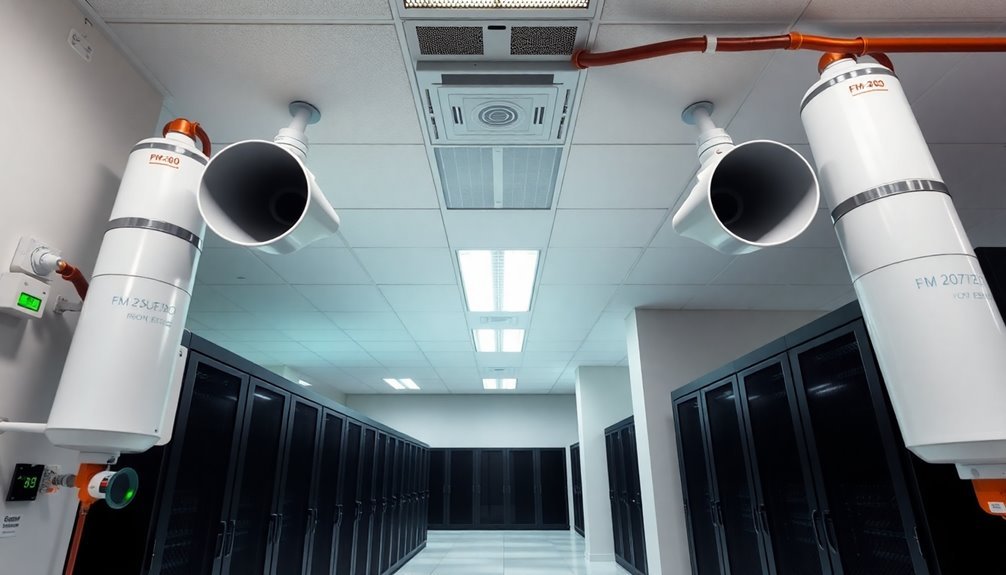You'll need three essential systems to protect your server room from discharge events effectively. First, maintain relative humidity between 40-60% using monitoring systems and humidifiers to prevent static electricity buildup. Second, install thorough water leak detection with spot sensors and sensor cables to catch potential leaks before they damage equipment. Third, implement clean agent fire suppression systems with proper nozzle placement and sealed entry points to quickly extinguish fires without harming electronics. Understanding these core protective measures will help you develop a more robust disaster prevention strategy for your facility.
Controlling Humidity For ESD Prevention

Every server room requires precise humidity control to prevent electrostatic discharge (ESD) and protect sensitive equipment. You'll want to maintain relative humidity (RH) between 40-60%, with 50% being the ideal level for minimizing static electricity risks. To achieve this, you need to implement thorough monitoring systems with strategically placed sensors throughout your server room.
Set up a real-time monitoring system that alerts you when humidity levels fall outside the recommended range. You should install both humidifiers and dehumidifiers to respond quickly to environmental changes. Installing proper ESD flooring can reduce humidification requirements and lower associated energy costs significantly.
High humidity can cause condensation and corrosion, while low humidity increases ESD risks. Don't forget to check your equipment manufacturers' specifications, as some hardware may have specific humidity requirements.
To enhance your ESD prevention strategy, install static control flooring that's permanently static-resistant. This infrastructure solution is more energy-efficient than relying solely on humidification. Follow ASHRAE recommendations for static control and guarantee your cooling systems work efficiently without creating additional heat load.
Water Leak Detection Systems
While maintaining proper humidity levels protects against ESD, water leaks pose an equally significant threat to server rooms. You'll need to implement thorough water leak detection systems to safeguard your critical equipment and data from potential water damage.
You should start by identifying all potential leak sources, including air conditioning units, cooling systems, and areas prone to condensation. Consider implementing spot detectors at these critical points for precise monitoring.
Install sensor cables under raised flooring at 3-foot intervals and ceiling guard sensors above drop ceilings to guarantee complete coverage.
You'll want to integrate these systems with a centralized monitoring platform that can track multiple zones and send instant alerts via email, SMS, or SNMP.
Don't forget to incorporate flood protect and control kits near critical equipment, as these berms can absorb liquid and create protective barriers during emergencies.
You should also integrate your leak detection system with your building management system for thorough monitoring.
Make sure you're conducting regular maintenance checks and testing your detection system's components.
Train your staff on proper system operation and emergency procedures.
This thorough approach will help prevent costly downtime, protect your valuable data, and guarantee business continuity.
Clean Agent Fire Suppression

In addition to water leak protection, you'll need a clean agent fire suppression system to protect your server room from fire damage. These systems quickly discharge specialized agents that smother fires and lower temperatures while minimizing business interruption. Clean agent systems have proven highly effective in replacing outdated Halon-based solutions that were phased out due to environmental concerns.
To provide effective protection, you'll want a thorough coverage with properly placed discharge nozzles and integration with reliable detection systems.
Preparing your server room for clean agent suppression requires attention to these vital elements:
- Seal all potential leakage points in walls and slabs using fire-retardant materials and fire caulk, including windows and pass-throughs.
- Install air-tight door seals with weather stripping and proper latching mechanisms, ensuring egress doors swing outward.
- Mount electromagnet door holders for any doors that must remain open during normal operations.
Regular maintenance is essential for system reliability. Schedule professional inspections to verify system effectiveness and compliance with safety standards.
Train your staff to perform routine checks and identify potential hazards. Keep equipment free from dust and debris accumulation, and maintain proper testing schedules.
Frequently Asked Questions
How Often Should Security Access Logs Be Reviewed for Suspicious Activity?
You'll need to review your security access logs daily for immediate threats, conduct weekly analyses for patterns, and perform monthly audits for thorough oversight. Don't forget to securely archive logs for future reference.
What Backup Power Systems Are Recommended for Server Room Protection?
You'll need both UPS and backup generators for thorough protection. Install a high-capacity UPS (3000-6000 VA) for immediate backup, and pair it with a generator for extended power outages.
What Temperature Range Is Optimal for Server Room Operation?
You'll want to maintain your server room between 68°F and 71°F for ideal performance, though the broader acceptable range is 50°F to 82°F. ASHRAE standards suggest keeping temperatures between 64.4°F and 80.6°F.
How Frequently Should Server Room Equipment Be Tested for Electrical Grounding?
You'll need to perform daily visual inspections of grounding connections, monthly resistance testing, quarterly thermal imaging checks, and annual thorough audits. Don't skip these checks, as they're essential for equipment safety.
What Materials Should Server Room Floors Be Made of to Prevent ESD?
You'll want to use static dissipative vinyl, conductive vinyl, or conductive rubber flooring that measures below 1.0 x 10^9 ohms to ground. These materials effectively prevent static buildup in your server room.
In Summary
You'll find these three key measures critical for protecting your server rooms from damaging discharge events. By maintaining proper humidity levels, installing water leak detection systems, and implementing clean agent fire suppression, you're creating multiple layers of defense. Don't overlook any of these safeguards – they work together to keep your valuable equipment safe from static, water, and fire-related threats.





Leave a Reply